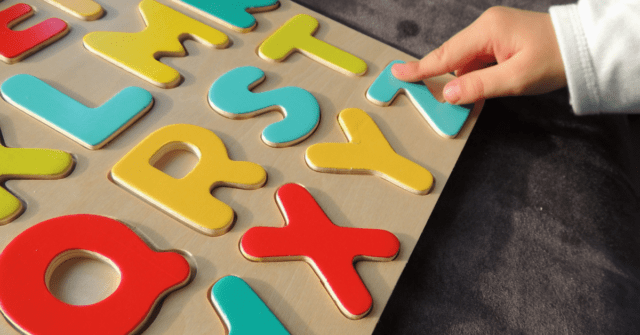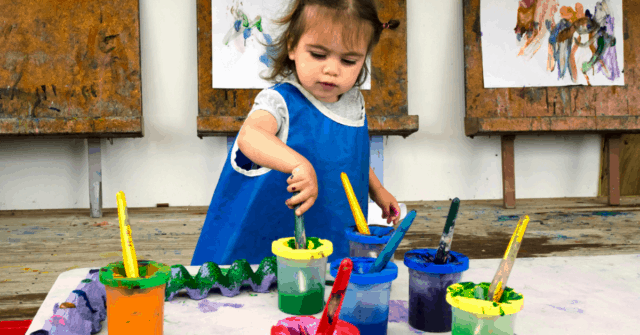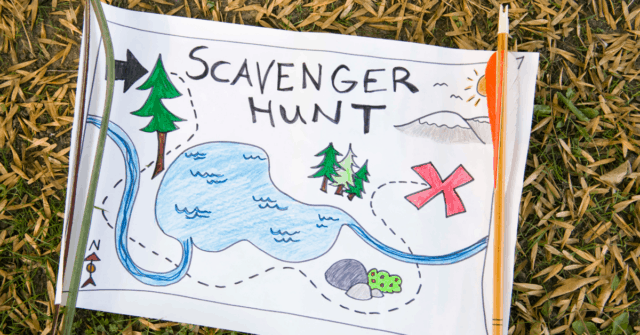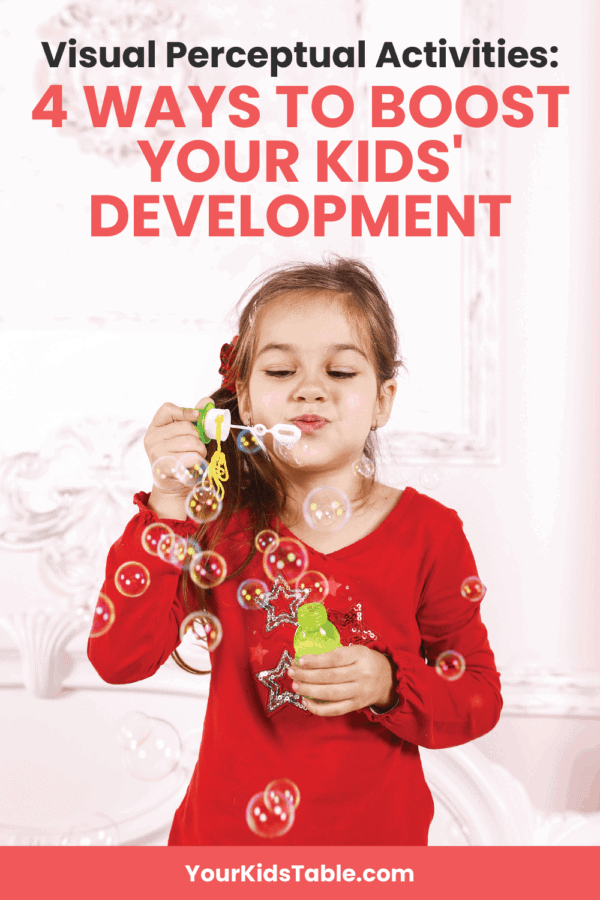Visual perceptual activities are an essential part of development and learning. Kids use visual perceptual skills every day during daily routines. These skills are building blocks for the brain!
Have you heard of visual perceptual skills? They’re a critical part of every child’s development, but it’s another one of those areas that just isn’t talked about much with parents.
When a child has visual perceptual difficulties, they may struggle in any learning environment, get frustrated easily, and can’t manage to keep their room clean.
Okay, A LOT of kids struggle with keeping their rooms clean.
But, as you’re about to learn, there’s a lot you can do to help your child strengthen their visual perceptual skills WITH visual perceptual activities.
I’m thrilled to invite Amy Hathaway MOT, OTR/L, CIMI-2, creator of DevelopLearnGrow.com, fellow occupational therapist, and mom, to Your Kid’s Table.
She’s an expert in visual perceptual skills, it’s an honor to have her here. I’ll let her take it away…
What Are Visual Perceptual Skills?
Visual perceptual skills involve the brain’s ability to interpret what is seen.
Our eyes see and take in information all around us. The brain has the job of making sense of what is seen.
This is much different than just seeing things clearly. It’s more than taking your kiddo to the doctor to see if he or she needs glasses.
Kids may see clearly (near and far), but can still have difficulties with perception.
Visual perception involves the brain making sense of patterns and shapes. It’s understanding how far away an object is based on it’s size.
The brain has to visually understand parts to whole, depth perception, and size differences. It interprets and learns volume, directionality, and positions of things in their environment.
Visual perceptual activities help the brain improve these skills.
Why Are Visual Perceptual Skills and Activities Important for Kids?
I strongly value the importance of visual perception, not only as part of my career, but as a mom with my own kids.
From the time my kids have been babies, our home has been full of visual perceptual activities, games, and toys!
Two of my kids are visual learners. One is not.
However, the visual activities have been great for all three of them! Two improved problem solving, attention, and creativity with their love of the activities.
And my third… the non-visual learner… was able to strengthen a part of his brain.
Instead of avoiding these types of play activities that he didn’t really like, he eventually participated in them.
The visual perceptual activities were simply around every day. No pressure for him to choose them.
But he did start to choose them. And, he actually enjoys them!
It was so exciting for me (as a mom AND as an occupational therapist!) to see him create new learning pathways.
Fast forward, he’s currently doing well in his honors geometry class!

How Are Visual Perceptual Activities Part of Daily Routines?
Visual perceptual development actually starts much earlier than you’d think. And the skills continue throughout childhood.
At an early age, newborn babies start to recognize patterns. They see the patterns of faces! They learn the position of the eyes, nose, and mouth on all the faces they see.
During play based learning activities, toddlers and preschoolers identify colors and shapes and patterns. The brain remembers colors or the sequences of patterns.
Kids learn that there are parts to a whole when they spot only part of their favorite shirt under clothes in a drawer.
They participate in a visual perceptual activity when they match various pairs of socks. Or, when they’re able to find a toy on a busy floor full of other toys.
They understand depth perception when climbing a new structure at the playground. Or, when approaching waves at the beach.
Visual perception is a big part of learning and academics.
Visual Perceptual Activities Are Important for Learning
In addition to kids using visual perception during daily activities, they’re an important component in learning.
Visual perceptual skills are used in reading, writing, math, science, and social studies.
Kids identify letters and numbers for reading. They learn the difference between b-d, p-q, or p-9.
When writing, kids use perceptual skills to position letters on page or on a line. They use them to organize math problems.
In science, kids learn size, shape, volume, and proportions using these skills.
During social studies lessons, kids develop an understanding of directional terms. They can follow a map or navigate a new building or part of a city using visual perceptual skills.
These are only a few examples, visual perception continues as kids’ brains continue to learn… all the way into junior high and high school.
4 Activities That Strengthen Your Kid’s Visual Perceptual Skills
#1 Strengthen Your Kid’s Eye Muscles
This is considered a building block for visual perception. Our eyes see, but we often don’t think about the small muscles that move the eyes.
Kids use their eye muscles so much every day. Just like any other muscle in the body, they should use them without the muscles getting tired.
Kids are required to visually attend to objects. Their eye muscles have to focus on near objects and far objects. And, the eye muscles also have to work together to follow moving objects.
When choosing activities to strengthen your kid’s eye muscles, it’s best to avoid screen activities and apps! Please, only use toys, games, and hands on activities.
Activities to try include:
- Use bubbles for popping, clapping, or stomping
- Play with ribbons and wands
- Roll cars or small rolling toys on a large open floor – this is great for focusing and watching them move
- Play games in a dark room or at night using flashlights or laser pointers
- Tape letters on the wall when using a flashlight to make it a learning activity (spell words)
An activity I use often to address visual tracking for school age kids is the Infinity Loop.

#2. Encourage Puzzle Activities
Matching activities are part of puzzle skills. Matching games and wooden pictures to picture puzzles are a good starting point for toddlers.
Shape puzzles are great activities. However, try to find shape puzzles that don’t have colors behind them.
For example, if a red square only fits into the red square opening, your child’s brain pays more attention to the color instead of the shape. Matching the colors is easier than matching shapes, so this doesn’t really address the skill.
For older kids, games like Perfection are great for matching complex shapes. There are many more visual perceptual games and toys available for kids.
Regular interlocking puzzles are excellent for visual perception and problem solving. Start with fewer pieces (4 to 8) and gradually work up to puzzles with 24 or more pieces.
You can even make your own puzzles. Cut a picture into several parts. See if your kiddo can reassemble it. You could cut large block letters or numbers and cut them up for a puzzle.
Puzzles are a great way for kids to work on problem solving and fine motor skills. Try not to help by pointing toward where a piece goes. (Or even by looking at the correct spot.) Instead, say “hmmm, where does it go?” and give them time to look and find it.
Also, try not to help them position or reposition a piece that may not have fit correctly on their first attempt.
Give them encouragement and simply say, “It almost fit. Try again!”
If you find that your kiddo really wants you to help with a puzzle, try to find one that’s less challenging.

#3. Use Arts & Crafts to Improve Visual Perceptual Activities
Arts and crafts are great for addressing visual perceptual skills. As an added bonus, they work on problem solving, creativity, and fine motor skills!
It’s important to find arts and craft activities that your kiddo can complete as independently as possible. They should be able to complete every step of the project without your help.
Arts and craft activities that work on visual perception can be as simple as tearing construction paper to create designs and pictures.
A model can be provided if you want to work on copying skills.
Visual memory can be addressed by showing a model of a project and then removing it. Then, your child creates it from memory.
On the flip side, creativity can be encouraged! Give a theme or scene and allow them to use their imagination. They have to think about the position and placement of all the parts of the picture.

#4. Play Visual Games During Daily Routines
You can incorporate visual perceptual activities into daily routines.
Play I Spy when you’re in the grocery store or driving in the car.
Try several versions of What’s Missing? For example, show them a group of figurines or kitchen items. They close their eyes, you remove one, and they guess which one is missing.
Other ways to play this: hide a puzzle piece and see if they can remember which piece is hidden. Or, remove a cuddle toy or a book from their shelf to see if they can guess what’s missing.
You can also work on visual skills through scavenger hunts. Give a list of requests for something brown, something that grows, etc. Try them both inside and outside.
More Visual Skills Activities for Kids
If you’d like more visual perceptual activities for your kids, then grab the Activities to Enhance Reading Skills Printable. The printable shares more visual skills activities. Additionally, it contains auditory, balance, and crossing midline activities for kids!
*Click here to get 43 Activities to Enhance Reading Skills in Kids*
All four of these different types of activities on the free printable help improve foundational skills needed for learning and reading.
More on Visual Perceptual Activities
How to Improve Reading with 15+ Visual Skills Activities
Art Projects for Kids – Support Reading, Writing, and Math Skills
An Easy Visual Motor Activity Using Magnets
17 Special Balance and Movement Activities to Improve Visual Skills
Amy Hathaway MOT, OTR/L, CIMI-2 is a licensed and registered occupational therapist. She is the founder of Develop Learn Grow. Amy has 18 years of experience as a pediatric occupational therapist. She enjoys collaborating with teachers, parents, therapists, administrators, and support staff in preschools & schools, as well as coaching and guiding parents of infants and toddlers in their homes.
Amy is married with three children.
